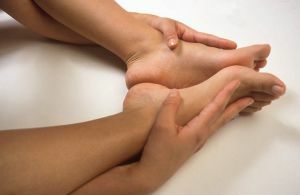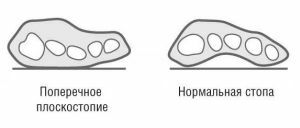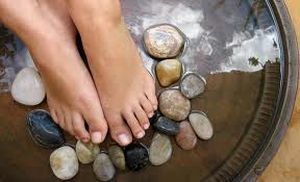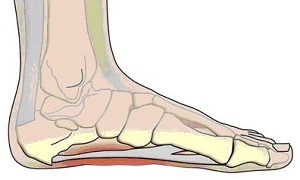 The human foot consists of many small bones, joints, ligaments and tendons connected together.
The human foot consists of many small bones, joints, ligaments and tendons connected together.
Incorrect wearing of shoes, excessive weight, a variety of injuries and many other reasons can disrupt the fragile balance of the system that the foot represents. Because of , the anatomical arches of the foot begin to flatten in the joint of , the joint or the location of the bones.
Over time, flattening may progress, and may remain at a certain stage continuously. And in fact, and in that case it gives cause to diagnose flat feet.
Contents of the article
- Types of the disease
- Why is the foot flattening?
- Symptoms that indicate the development of the pathology
- How to diagnose the disease
- Treatment of the disease
- Video: Transverse platypodia and bones on the legs
Types of the disease
The classifies several types of this disease:
- The transverse platypodia , in which the foot "spreads" in width, developsbone-cartilaginous growth. Instead of giving a load to the arch support, the foot is flattened and expands an additional support in the form of a joint, popularly known as a "bone".The risk group for this type of disease is women and men aged 35 to 55, especially those who are overweight.
- Longitudinal flat feet, , on the contrary, manifests itself in the extension of the foot in length and is most often observed at a young age - 16-25 years.
- With the combined flatfoot , both types of deformations are simultaneously observed, but all of them lead to a flattening of the arch of the foot. The combined variant of the disease is observed most often.
Usually a predisposition to flat feet is inherited, but there are also types of acquired flat feet, to which there was no inclination.
- Static - formed due to standing work, hypodynamia, excess weight, increased loads on the foot, endocrine diseases.
- Paralytic - arose after the paralysis of the limbs and the dysfunction of the muscles that hold the arch of the foot.
- Traumatic - physical changes due to trauma.
- Ricky - acquired, developed due to a lack of vitamin D.
By the degree of development, the weak, initial, and progressing flat feet.
Consider transverse flatfoot, one of the most common types of disease, closer.
 What can cause inflammation of the joints of the foot. How to not miss the right time to see a doctor read in our article.
What can cause inflammation of the joints of the foot. How to not miss the right time to see a doctor read in our article. A useful addition to the treatment of arthrosis - orthopedic knee pads for arthrosis will help reduce pain and accelerate recovery. How to choose and correctly carry the device read here.
Why is the foot flattening?
There are several reasons for transverse flatfoot.
- Genetic predisposition. As already mentioned, most often flat feet manifest as a congenital disease. It arises from the inherent weakness of the muscles of the arched arch, which is also called the "aristocratic foot".If a person leads a healthy lifestyle, eats properly, receives moderate physical activity, wears good shoes, then this type of flatfoot does not progress and practically does not cause trouble.
- Disturbances in the muscular and ligamentous apparatus of the foot. In a healthy person, the phalanges of the toes should run parallel to each other. But, as a rule, the slightest and inconspicuous disruption in the development of muscles or ligaments leads to the formation of a fan-shaped arrangement of phalanges. Over time, the phalanges "creep" in the sides, and because of this, a transverse flatfoot arises.
- Overweight. The arch of the foot, like its muscular and ligament apparatus, is designed to work only with a certain weight. If it goes beyond the norm, the load on the foot increases, it flattenes.
- The same situation is observed in people with normal weight, but having an excess load on the foot due to the type of activity. So, the work of a lecturer, teacher, factory worker and many other professions are considered "standing", that is, people spend most of their days on their feet. Excessive loads disrupt the balance of the foot, the acquired flat feet develop, which is considered an occupational disease.
- Traumas of the foot are one of the most common factors in the development of flat feet in men. Fractures of the foot bones, dislocations, stretching of the muscles and ligaments, violation of the integrity of the calcaneus bone lead to disruption of the foot apparatus and progressive flat feet.
- Walking on heels, wearing uncomfortable shoes with an unsuitable shoe and other violations of foot hygiene - almost one of the most common causes of the development of acquired flat feet. When walking on heels, for example, the entire weight of the body is transferred to the front of the foot. Instead of spreading evenly over the entire support, it presses and eventually deforms bones that are not ready for such loads. It is because of the heels, and also because of the transfer of the hereditary predisposition to flat feet along the female line, that the ratio of women and men suffering from this disease is eight to two, respectively.
Symptoms that indicate the development of the pathology
The development of flatfoot is easy to recognize. The most common symptoms that accompany the transverse are flatfoot:
- The constant pain of and the appearance of a strong feeling of fatigue in the feet, which is especially pronounced by the end of the day.

- Burning and cramps in the shin area , usually not associated with uncomfortable position, hypothermia and other external factors.
- Deformation of the foot and changing the location of the phalanges of the fingers.
- The appearance of a kind of cone at the base of the thumb( usually called a "bone").
- With progressive flat feet - violation of posture , pain in knees and pelvic joints, discomfort in the back.
- When the disease develops, deforms the entire front part of the foot .
How to diagnose
Based on the results of the examination, the doctor may prescribe various treatment methods.

In the picture, a foot check for longitudinal and transverse flatfoot
Treatment of
disease Treatment of transverse flatfoot in adults should be complex.
Conservative methods of include:
- Reduces the load on the foot, up to its immobilization in especially severe cases.
- Wearing individually selected orthopedic shoes .In difficult cases, this can be a special footwear, fixing not only the foot, but also the shin. Orthopedic insoles and helium inserts are used at the initial stage of flatfoot. All of them should be appointed by a doctor and selected individually.
- Weight loss measures for , if it was determined to be excessive.
- General strengthening exercises for the treatment of transverse flat feet, included in the curative physical training course.
- Medications( analgesics) are prescribed with progressive flat feet and the presence of arthrosis or bursitis.
- Physiotherapy and massage , aimed at relieving pain, relaxing the muscles of the foot.
- To relieve tension, prevent cramps, reduce pain, also uses refreshing foot baths, cool compresses, ointments based on mint and menthol.
Nonconservative, folk treatment of of transverse flatfoot is mainly aimed at alleviating the pain that occurs during the load of feet during flatfoot.
These include ice compresses, foot baths based on peppermint, lemon balm, thyme, marigold, chamomile, linden and lavender.
If conservative treatment methods do not show results, irreversible changes occur in the foot, the patient suffers severe pain, then is prescribed surgical intervention. As a result of surgery, deformities of the forefoot are treated surgically. A number of modern techniques allow to do this without the subsequent application of gypsum - thus, the rehabilitation period is reduced.
Surgical treatment of transverse flatfoot has a significant drawback - the need for complete cessation of loads on the foot during preparation and rehabilitation, but at the same time the issue is solved crucially - the flat foot does not progress and no longer causes regular concern, as in the case of conservative treatment.
To never have problems with the flatfoot , you should pay attention to the convenience of shoes, do not wear high heels, maintain your weight in the norm. People of "standing" professions need to rest more often, change their positions during the performance of duties.
Like most other diseases, flatfoot is easier to prevent than cure.



